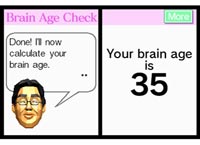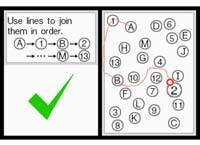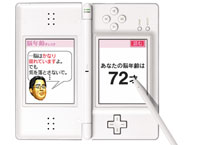|
|
|||||||
|
|
|||||||
|
|||||||
| | Web Japan >> | Trends in Japan >> | Arts & Entertainment >> | Brain Training for Young and Old | |
|
BRAIN TRAINING FOR YOUNG AND OLD Game Makers Discover New Market among Seniors (July 28, 2006) Handheld electronic games, once the exclusive domain of the young, are acquiring a rapidly expanding fan base among the middle-aged and elderly, resulting in some cases in product shortages. The driving force behind this surge in interest is the phenomenon of noh tore (brain training), or games specially developed to stimulate the brain's activity. Breakthrough via Handheld Game Consoles The brain training boom began to take off in May 2005 with the release of Brain Age: Train Your Brain in Minutes a Day, a piece of software developed for the Nintendo DS handheld game console. The software, edited by Dr. Kawashima, is simple in that players use a touch pen to answer sums and other reasoning and memory problems. Its popularity stems from the fact that, since it is used on a handheld game console, these exercises can easily be performed anytime and anywhere. A second version of the software was released in December 2005, and the two versions have been bona fide hits, selling in excess of five million copies combined, as of June 2006. The software recorded particularly high sales in the days prior to and following Japan's Respect for the Aged Day in September. Short Supply A North American version of the DS brain training software was released in April in the United States under the title Brain Age, and a European version titled Dr. Kawashima's Brain Training: How old is Your Brain? was released throughout Europe and in Australia in May and June, further fueling the brain training boom throughout the world. A PSP version of Dr. Kawashima's software titled Brain Trainer Portable that was released for Sony's portable console has also boasted strong sales. A number of similar brain training software programs targeting seniors have been introduced for both the DS and the PSP, signaling the start of a heated battle in the handheld game market to win over the newly discovered senior customer base. Copyright (c) 2006 Web Japan. Edited by Japan Echo Inc. based on domestic Japanese news sources. Articles presented here are offered for reference purposes and do not necessarily represent the policy or views of the Japanese Government. |
GAMING ON THE GO (February 22, 2005) |
|
|





